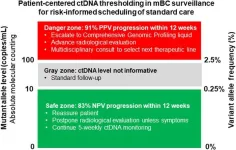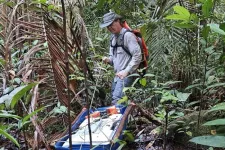UC Irvine scientists invent new drug candidates to treat antibiotic-resistant bacteria
2025-02-24
Irvine, Calif., Feb. 24, 2025 — There’s an arms race in medicine – scientists design drugs to treat lethal bacterial infections, but bacteria can evolve defenses to those drugs, sending the researchers back to square one. In the Journal of the American Chemical Society, a University of California, Irvine-led team describes the development of a drug candidate that can stop bacteria before they have a chance to cause harm.
“The issue with antibiotics is this crisis of antibiotic ...
A history of isolation and alcohol use may impact depression treatment
2025-02-24
Ketamine can effectively treat depression, but whether depressed patients with alcohol use disorder can safely use ketamine repeatedly remains unclear clinically. To investigate this possibility, Mohamed Kabbaj and colleagues from Florida State University modeled aspects of human depression in rats using long-term isolation and assessed how isolation and alcohol exposure alter ketamine intake. The authors found that a history of isolation and alcohol use influence the rewarding properties of ketamine in a sex-dependent manner.
Female rats took ketamine more than males in general. Prior alcohol use increased female rat ketamine ...
A new strategy to promote healthy food choices
2025-02-24
Poor food decisions and eating habits can contribute to excessive weight gain and health problems. Nutritional labels meant to convey healthiness instead may create negative expectations about taste or pose as a time-constraining hurdle for shoppers. Doris Schicker and Jessica Freiherr, from the Fraunhofer Institute for Process Engineering and Packaging, led a study in JNeurosci to explore whether pairing food labels with a sensory stimulus, like odor, affects how people perceive foods and thus promotes healthy shopping. ...
Report reveals high levels of added sugar in US infant formula despite medical recommendations
2025-02-24
LAWRENCE — Added sugar, derived from cheap crops like corn, is bad for babies.
According to the American Heart Association, added sugars are full of energy but lack nutritional value, boosting odds of obesity, type 2 diabetes, cardiovascular disease and other health problems.
But a study published today from the University of Kansas in the Journal of Food Composition and Analysis shows most infant formulas on the U.S. market contain primarily added sugars rather than the healthier, naturally occurring lactose found in cow-milk base that would be best for babies because ...
Arctic study urges stronger climate action to prevent catastrophic warming
2025-02-24
Remember when 2°C of global warming was the doomsday scenario? Well, we're now staring down the barrel of something much worse. From the fish on your plate to the weather outside your window, everything's about to change.
A new study by an international team of researchers, including Jackie Dawson, full professor, Geography, Environment and Geomatics at the University of Ottawa’s Faculty of Arts, underscores the grave risks posed by insufficient national commitments to reducing greenhouse gas emissions.
“Our findings ...
New technique to measure circulating tumor DNA in metastatic cancer may improve disease progression surveillance and patient outcomes
2025-02-24
Philadelphia, February 24, 2025 – In metastatic cancer surveillance, monitoring the actual concentrations of circulating tumor DNA (ctDNA) may be critical. Researchers showed that absolute ctDNA concentration thresholds can be defined to rule out or predict impending cancer progression. They introduce a dual threshold model in a novel study in The Journal of Molecular Diagnostics, published by Elsevier, that may improve cancer surveillance, patient stratification, and risk-informed, personalized treatment by providing more accurate and timely assessment of disease progression.
Lead ...
One day of sleep deprivation can alter your immune system and increase inflammation
2025-02-24
New research reveals insight into the impact sleep quality has on a person’s immune system, and how it could be linked to the development of diseases such as obesity, diabetes, and cardiovascular diseases.
The study, published in The Journal of Immunology, found that even a single night of 24-hour sleep deprivation in young, lean, and healthy individuals altered the profile of immune cells that help regulate the immune system to resemble that of individuals with obesity - a condition known to drive chronic inflammation. This suggests that the immune system is highly sensitive to sleep and may adapt rapidly to changes in sleep pattern. ...
Study shows primary care and telehealth can deliver life-changing diabetes care
2025-02-24
Researchers at The University of Colorado Anschutz Medical Campus and colleagues at Massachusetts General Hospital, have found that people with diabetes can achieve the same positive results using advanced insulin technology when trained by their primary care providers (PCPs) or through telehealth as they would by seeing a specialist in person.
The study’s findings, which focused on Type 1 diabetes, are a major step forward in expanding access to cutting-edge care for people with diabetes, especially for those living in rural ...
The brain’s map of space: A new discovery about how our brains represent information
2025-02-24
A new study reveals how the brain’s "place cells" create internal maps to help us navigate. These specialized neurons, found in the hippocampus, were once thought to rely on precisely ordered patterns for spatial coding. However, researchers have found that their activity, which appears disordered in large spaces, actually follows universal mathematical principles. This surprising discovery suggests that randomness, not strict organization, is key to how our brains encode information about our experiences. The findings could reshape our understanding of brain function ...
AI to diagnose invisible brain abnormalities in children with epilepsy
2025-02-24
Scientists have developed an AI-powered tool that detects 64% of brain abnormalities linked to epilepsy that human radiologists miss.
MELD Graph is an AI tool that could drastically change the care for 30,000 patients in the UK and 4 million worldwide with one cause of epilepsy, researchers say.
The study, published today in JAMA Neurology by a team at King’s College London and University College London (UCL), shows how the tool significantly improves the detection of focal cortical dysplasia’s (FCDs) which is a leading cause of epilepsy.
Researchers say the tool will speed up diagnosis times, get patients the surgical treatment ...
COVID-19 vaccination and odds of post–COVID-19 condition symptoms in children ages 5 to 17
2025-02-24
About The Study: The results of this study suggest that mRNA COVID-19 vaccination may be a protective factor against post–COVID-19 condition in children following SARS-CoV-2 infection. These findings suggest benefits of COVID-19 vaccination beyond those associated with protection against acute COVID-19 and may encourage increased pediatric uptake.
Corresponding Author: To contact the corresponding author, Anna R. Yousaf, MD, email pgy6@cdc.gov.
To access the embargoed study: Visit our For The Media website at this link https://media.jamanetwork.com/
(doi:10.1001/jamanetworkopen.2024.59672)
Editor’s Note: Please see the article for additional ...
Sudden cardiac arrest among young competitive athletes before and during the COVID-19 pandemic
2025-02-24
About The Study: This cohort study found no increase in sudden cardiac arrest/sudden cardiac death in young competitive athletes in the U.S. during the COVID-19 pandemic, suggesting that reports asserting otherwise were overestimating the cardiovascular risk of COVID-19 infection, vaccination, and myocarditis. Many athlete cases shown in social media video montages occurred before the pandemic yet claimed COVID-19 infection or vaccination raised the risk of sudden cardiac arrest/sudden cardiac death.
Corresponding Author: To contact the corresponding author, Jonathan A. Drezner, MD, email jdrezner@uw.edu.
To access the embargoed study: Visit our For The Media website at this ...
Mortality among US physicians and other health care workers
2025-02-24
About The Study: The results of this cross-sectional study suggest that although physicians and most health care workers experienced lower mortality rates compared with the general population, this benefit did not fully extend to female individuals or racial and ethnic minority groups. Renewed efforts are needed to address health inequities within the health care workforce.
Corresponding Author: To contact the corresponding author, Anupam B. Jena, MD, PhD, email jena@hcp.med.harvard.edu.
To access the embargoed study: Visit our For The Media website at this link ...
Telemedicine adoption and low-value care use and spending among fee-for-service Medicare beneficiaries
2025-02-24
About The Study: In this cohort study, telemedicine adoption was associated with modestly lower use of 7 of 20 examined low-value tests (most point-of-care) and no changes in use of other low-value tests, despite a small rise in total visits that might offer more testing opportunities. Results suggest possible benefits of telemedicine and mitigate concerns about telemedicine contributing to increased spending.
Corresponding Author: To contact the corresponding author, Ishani Ganguli, MD, MPH, email iganguli@bwh.harvard.edu.
To access the embargoed study: Visit our For The Media website at this link ...
Researchers find telemedicine may help reduce use of unnecessary health tests
2025-02-24
Low-value care—medical tests and procedures that provide little to no benefit to patients—contributes to excess medical spending and both direct and cascading harms to patients. A research team from Mass General Brigham and their collaborators have found that telemedicine may help to reduce the use of low-value tests. The work is published in JAMA Internal Medicine.
“In theory, widespread adoption of telemedicine post-pandemic may influence low-value testing—such as Pap smears and prostate cancer screenings in older adults, and imaging scans for straightforward cases of low back pain,” said lead author Ishani ...
Research provides new detail on the impact of volcanic activity on early marine life
2025-02-24
Analysis of fossilised rocks known as stromatolites from more than two-and-a-half billion years ago has provided new insights into the conditions on Earth before the evolution of oxygen.
Led by Northumbria University researcher, Dr Ashley Martin, an international team with expertise in geology, microbiology, and geochemistry, worked in partnership to investigate nitrogen cycling patterns within ancient stromatolites, preserved in southern Zimbabwe.
Nitrogen is vital for all life on Earth but must first be converted into useable, bioavailable, forms as it passes through the atmosphere, soil, plants and animals in the nitrogen cycle.
The team believe the unusual nitrogen ...
NCSA awarded funding to continue AI-focused NSF REU program
2025-02-24
The National Center for Supercomputing Applications received funding from the U.S. National Science Foundation (NSF) to renew its annual Research Experience for Undergraduates (REU) program, the Future of Discovery: Training Students to Build and Apply Open Source Machine Learning Models and Tools (FoDOMMaT).
Housed in NCSA’s Center for Artificial Intelligence Innovation (CAII), the 10-week on-site experience brings about 10 undergraduate students each year from a variety of academic backgrounds to the University of Illinois Urbana-Champaign campus to engage in cutting-edge machine learning and deep learning projects, developing ...
New USF study identifies urgent need to protect coastal marine ecosystems
2025-02-24
TAMPA, Fla. (Embargoed until Feb. 24, 2025) – A new study led by the University of South Florida highlights the urgent need to protect marine ecosystems in shallow water near the shore – an area that many beachgoers don’t realize is highly important to fish populations. Known as tidal flats, these coastal waters are critical to global seafood supplies, local economies and overall marine health.
The findings from a team of interdisciplinary marine experts, “Habitat management and restoration as missing ...
Mega-iceberg from Antarctica on collision course with South Georgia: harbinger of things to come?
2025-02-24
It is no strange sight to see icebergs break off of the Antarctic ice cap and drift away, like the gigantic sheet of ice that is currently heading for the island of South Georgia. But climate change is making it happen more frequently, with ever-larger icebergs in the waters around Antarctica. Researchers from Utrecht University are studying the routes that icebergs followed during geological periods of rapid ice cap deterioration, such as the ends of ice ages. That provides crucial information about the effect of melting icebergs on the oceans, and its consequences for the future. In the process, ...
Beneath the bog: FAU awarded $1.3 million to track carbon and gas flow in peatlands
2025-02-24
Peatlands, a type of wetland found around the globe at all latitudes – from the Arctic to the tropics – are important ecosystems that store vast amounts of carbon. In fact, peatlands hold about one-third of the world’s soil carbon, despite covering only about 3% of the Earth’s land surface. When peatlands are disturbed or altered, they can release that carbon back into the atmosphere as greenhouse gases like methane. Peatlands are valuable ecosystems both for their biodiversity and for their role in regulating climate.
Researchers ...
ETRI to collaborate on semiconductor technology with US Argonne National Laboratory
2025-02-24
Korean researchers will begin collaborating in earnest with the U.S. Department of Energy’s (DOE) Argonne National Laboratory (ANL) on semiconductor technology research.
Electronics and Telecommunications Research Institute (ETRI) announced on Jan. 6 (local time) that it has agreed to establish a mutual cooperation system to develop semiconductor technologies with Argonne National Laboratory in Illinois, USA.
ETRI has possessed the technology to develop and manufacture silicon detectors for high-energy particle detectors since the early 2000s ...
Unexpected discoveries in study of giraffe gut flora
2025-02-24
The gut bacteria of giraffes are not primarily determined by what they eat, but by the species they belong to. This is shown in a new study from Uppsala University and Brown University in which researchers have analysed the link between diet and gut flora in three giraffe species in Kenya. The study also provides new knowledge that can help secure the food supply of endangered giraffe species.
In a new study published in Global Ecology and Conservation, researchers have analysed the relationship between the diet and microbiome, or gut flora, of giraffes in Kenya. By sequencing plant and bacterial DNA from faecal samples, they were able to investigate both the bacterial composition ...
Not all heart inflammation is the same
2025-02-24
A group of Berlin researchers in collaboration with international scientists have found differences in heart inflammation caused by COVID-19, anti-COVID-19 vaccination, and non-COVID-19 myocarditis. The find paves the way for more personalized therapies, they report in “Nature Cardiovascular Research.”
Heart inflammation, or myocarditis, differs depending on its cause. A collaborative study led by Dr. Henrike Maatz, a scientist in the Genetics and Genomics of Cardiovascular Diseases lab of Professor Norbert Hübner at the Max Delbrück ...
New home-based intervention could reduce emergency hospital admissions for older people
2025-02-24
A new service aimed at supporting older people who are starting to become frail, could reduce emergency hospital admissions by more than a third and save the NHS money, finds a new study led by UCL researchers.
The results from the clinical trial, published in The Lancet Healthy Longevity and funded by the National Institute for Health and Care Research (NIHR), evaluated the effect and cost-effectiveness of a new service, consisting of six personalised home-based visits from a support worker, tailored to each person to identify what they need to stay well and independent.
Interventions ...
Can exercise help colon cancer survivors live as long as matched individuals in the general population?
2025-02-24
Physical activity may help colon cancer survivors achieve long-term survival rates similar to those of people in the general population, according to a recent study published by Wiley online in CANCER, a peer-reviewed journal of the American Cancer Society.
Individuals with colon cancer face higher rates of premature mortality than people in the general population with matched characteristics such as age and sex. To assess whether exercise might reduce this disparity, investigators analyzed data from two posttreatment trials in patients with stage 3 colon cancer, with a total of 2,875 patients who self-reported ...
[1] ... [548]
[549]
[550]
[551]
[552]
[553]
[554]
[555]
556
[557]
[558]
[559]
[560]
[561]
[562]
[563]
[564]
... [8713]
Press-News.org - Free Press Release Distribution service.








